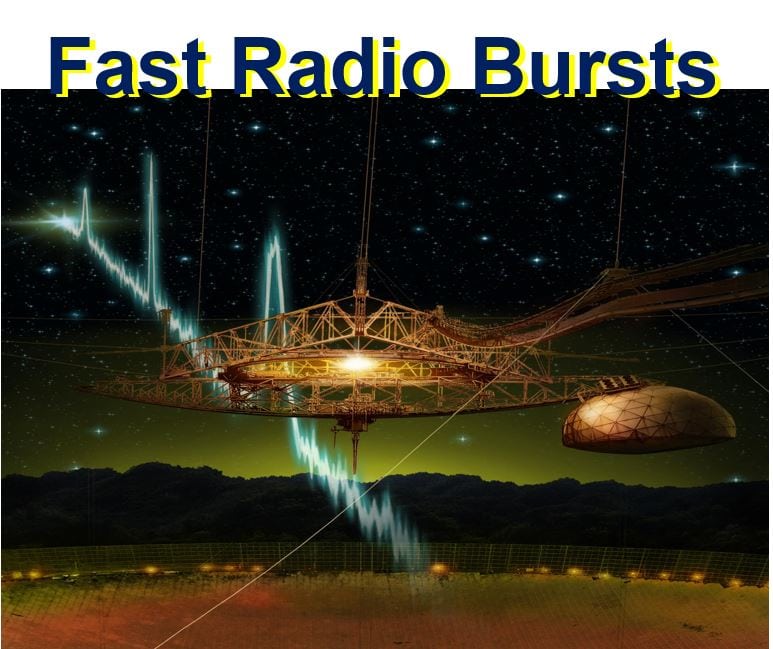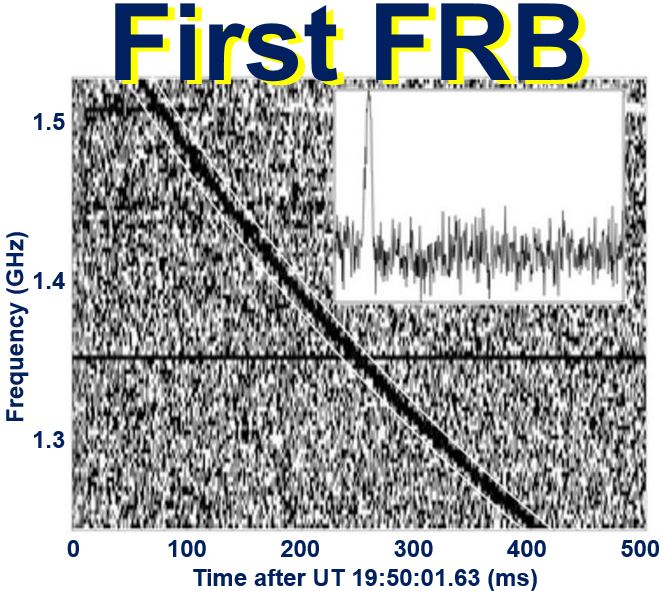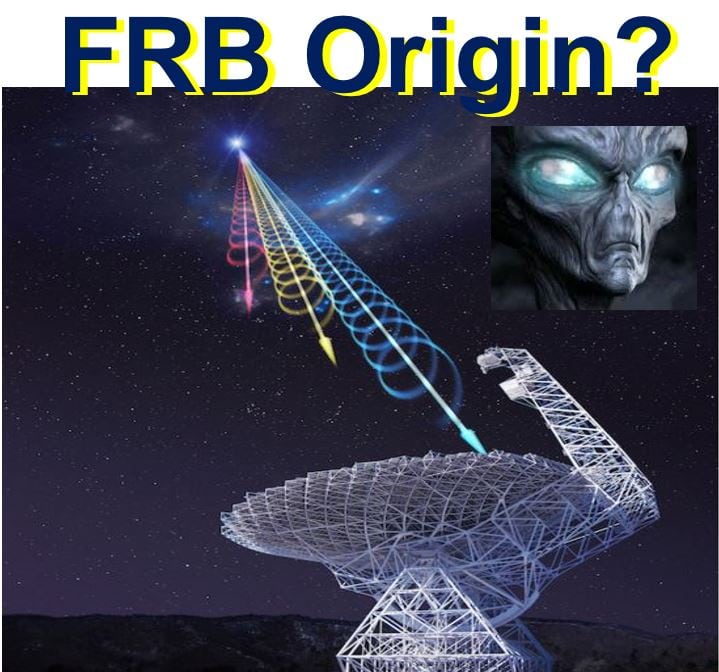Multiple fast radio bursts coming from beyond the Milky Way have been detected by scientists, who are super excited but unable to explain why they keep repeating. Nobody can explain why this is happening, and suggestions have ranged from rotating neutron stars to super-advanced megastructures made by smart extraterrestrials.
A team of scientists explained in the prestigious journal Nature (citation below) that these FRBs (Fast Radio Bursts) come from an immensely-powerful object which sporadically produces multiple bursts in under one minute.
All previous FRB detections have involved just one-off events – they were never repeated. Hence, most scientists believed these enigmatic pulses come from cataclysmic incidents that destroy their source, such as a neutron star collapsing into a black hole or a star exploding into a supernova.
 An artist’s impression of the Arecibo telescope with its suspended support platform of radio receivers with a sequence of millisecond-duration radio flashes racing towards the dish. (Image: mcgill.ca. Credit: Danielle Futselaar)
An artist’s impression of the Arecibo telescope with its suspended support platform of radio receivers with a sequence of millisecond-duration radio flashes racing towards the dish. (Image: mcgill.ca. Credit: Danielle Futselaar)
Fast radio bursts may have different origins
This new finding, however, clearly shows that at least some FRBs have different origins.
FRBs, which only last a few milliseconds (thousandth of a second), have both fascinated and puzzled scientists since they were first detected almost ten years ago.
In spite of extensive follow-up efforts, astronomers and astrophysicists until now have searched in vain for repeat bursts.
All that changed on 5th November 2015, when Paul Scholz, a PhD student at McGill University was sifting through results from observations carried out by the Arecibo radio telescope in Puerto Rico – the largest radio telescope in the world.
 According to Swinburne University of Technology: “Fast radio bursts are intense bursts of radio emission that have durations of milliseconds and exhibit the characteristic dispersion sweep of radio pulsars. The first was discovered in 2007 by Lorimer et al., although it was actually observed some six years earlier, in archival data from a pulsar survey of the Magellanic clouds. It was dubbed the ‘Lorimer Burst’.” (Image: Swinburne University)
According to Swinburne University of Technology: “Fast radio bursts are intense bursts of radio emission that have durations of milliseconds and exhibit the characteristic dispersion sweep of radio pulsars. The first was discovered in 2007 by Lorimer et al., although it was actually observed some six years earlier, in archival data from a pulsar survey of the Magellanic clouds. It was dubbed the ‘Lorimer Burst’.” (Image: Swinburne University)
The new data that had been gathered in May and June and run through a supercomputer at the University’s High Performance Computing Centre, showed a number of bursts with properties consistent with those of an FRB that had been detected in 2012.
Surprise and excitement
Scholz and colleagues found the repeat signals both surprising and incredibly exciting.
Scholz said:
“I knew immediately that the discovery would be extremely important in the study of FRBs.”
Scholz’ office colleagues gathered around his computer as he poured over the remaining output from the specialized software used to search for radio bursts and pulsars. He eventually found that there had been a total of ten new bursts!
The finding suggests that these FRBs must have come from an extremely exotic object, such as a rotating neutron star with unprecedented power that enabled the emission of ultra-bright pulses, the scientists said.
The finding might also represent the first discovery of a sub-class of the cosmic fast-radio-burst population.
 Many people (mainly lay individuals) speculate that these fast radio bursts come from advanced alien civilisations. (Image: adapted from wisc.edu)
Many people (mainly lay individuals) speculate that these fast radio bursts come from advanced alien civilisations. (Image: adapted from wisc.edu)
First author, Laura Spitler, a postdoctoral researcher at the Max Planck Institute for Radio Astronomy in Bonn, Germany, said:
“Not only did these bursts repeat, but their brightness and spectra also differ from those of other FRBs.”
FRBs come from very far away
Researchers think that these and other radio bursts come from faraway galaxies, based on the measurement of plasma dispersion.
Pulses that travel through the Universe are distinguished from man-made interference by the influence of interstellar electrons, which slow down radio waves, making them travel at lower radio frequencies.
The ten radio bursts that were recently discovered, like the one picked up in 2012, have three times the maximum dispersion measure that would be expected from a source inside the Milky Way.
However, the most likely implications of the new Arecibo finding – that the repeating radio bursts came from a very young neutron star from a distant galaxy, clash with the results of a study published by another research team in Nature last week.
According to that paper, FRBs are related to cataclysmic events, such as short gamma-ray bursts, which never generate repeat events.
There may be 2 or more kinds of FRBs
Victoria Kaspi, a physics professor at McGill, a senior member of the team that conducted the Arecibo study, said:
“However, the apparent conflict between the studies could be resolved, if it turns out that there are at least two kinds of FRB sources.”
The research team hopes it will soon be able to identify the galaxy where the radio bursts came from.
To be able to do this, they will need to detect bursts using telescopes with considerably more revolving power than Arecibo, a NSF-sponsored facility with a 305-metre-wide dish.
Using a technique known as interferometry, performed with radio telescope arrays spread over long geographical distances, the scientists may be able to achieve the required resolution.
We must find FRB’s host galaxy
Corresponding author for the Nature paper, Jason Hessels, associate professor at the University of Amsterdam and the Netherlands Institute for Radio Astronomy, said:
“Once we have precisely localized the repeater’s position on the sky, we will be able to compare observations from optical and X-ray telescopes and see if there is a galaxy there. Finding the host galaxy of this source is critical to understanding its properties.”
Kaspi, who is Director of the McGill Space Institute, said that Canada’s CHIME telescope could help unravel the puzzle. Thanks to the novel design of the nearly-completed apparatus, it should be able to detect dozens of FRBs each day, she says.
Kaspi said:
“CHIME will further our quest to understand the origin of this mysterious phenomenon, which has the potential to provide a valuable new probe of the Universe.”
In an Abstract in the journal, the authors wrote:
“Although there may be multiple physical origins for the population of fast radio bursts, these repeat bursts with high dispersion measure and variable spectra specifically seen from the direction of FRB 121102 support an origin in a young, highly magnetized, extragalactic neutron star.”
The McGill scientists were supported by the Canadian Institute for Advanced Research, the Natural Sciences and Engineering Research Council of Canada, the Canada Research Chairs program, the Fonds de recherche du Québec – Nature et technologies, and Lorne Trottier Chair in Astrophysics & Cosmology.
Last week, a team of scientists said they pinpointed the origin of a fast radio burst – a galaxy 6 billion light years from here.
Citation: “A repeating fast radio burst,” L. G. Spitler, P. Scholz, J. W. T. Hessels, S. Bogdanov, A. Brazier, F. Camilo, S. Chatterjee, J. M. Cordes, F. Crawford, J. Deneva, R. D. Ferdman, P. C. C. Freire, V. M. Kaspi, P. Lazarus, R. Lynch, E. C. Madsen, M. A. McLaughlin, C. Patel, S. M. Ransom, A. Seymour, I. H. Stairs, B. W. Stappers, J. van Leeuwen & W. W. Zhu. Nature. 2 March 2016. DOI: doi:10.1038/nature17168.
Video – Fast Radio Bursts
In this video, astrophysicists talk about fast radio bursts.
